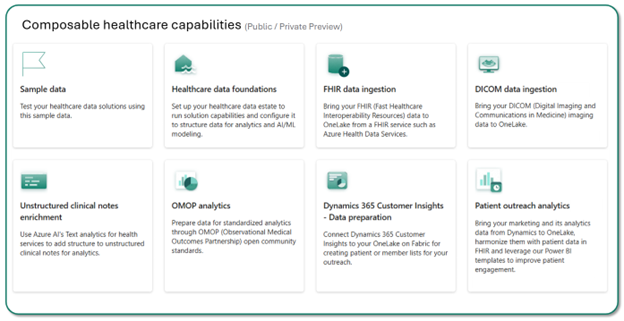Healthcare data solutions in Microsoft Fabric
With an increased effort in maintaining healthcare data, and with the correct data management strategies from Microsoft, healthcare organizations can use healthcare data solutions to gain insights. With this unified software as a service (SaaS) solution, you have a single source of truth for your data and analytics, providing more secure, democratized insights. By using this solution that is powerful, open, and scalable, you can accelerate time-to-value through cost management and spend optimization, thus making the most of your data investment.
With healthcare data solutions capabilities, organizations can:
Break down data and include diverse healthcare data in a single repository.
Create connected experiences at each point of care, empowering their workforce and unlocking value from clinical and operational data.
Unify data at every layer: One copy of data in the lake and one product experience for collaboration, governance, and unification of the business model to ensure that resources are cost-optimized.
Allow customers to run large-scale analytical scenarios in a cost-effective manner because it includes lakehouse architecture that combines data lakes and data warehouses.
Provide a state-of-the-art, multiple-model, bio-medical lakehouse in the cloud.
Capabilities of healthcare data solutions in Microsoft Fabric include:
Healthcare data model
Healthcare transformations
Healthcare analytical solutions
The following diagram lists the set of composable capabilities that improve time-to-value for cloud analytics.
FHIR data ingestion - Ingest FHIR data into OneLake by using a FHIR service, such as Azure Health Data Services.
DICOM data ingestion – Ingest, store, and analyze DICOM medical imaging data in OneLake.
Healthcare data foundations - Set up your healthcare data estate to run solution capabilities and change it to structure the data for analytics and AI/machine learning modeling.
Unstructured clinical notes enrichment - To enrich the clinical notes, you can add structure to the unstructured clinical notes by using Azure AI Text analytics for health.
OMOP Analytics - Prepare data by using Observational Medical Outcomes Partnership (OMOP) open community standards for standardized analytics.
Dynamics 365 Customer Insights - Data preparation - Allow the connection between Dynamics 365 Customer Insights - Data and your OneLake instance in Fabric for creating patient or member segments for your outreach.
